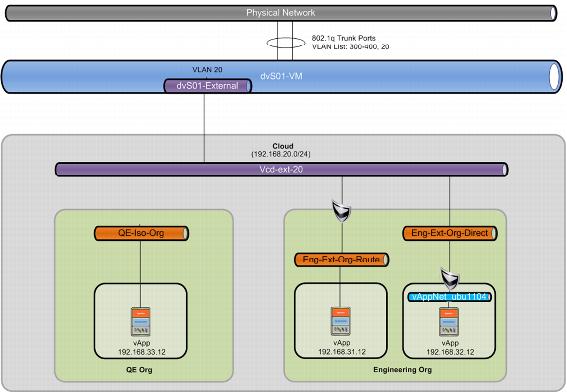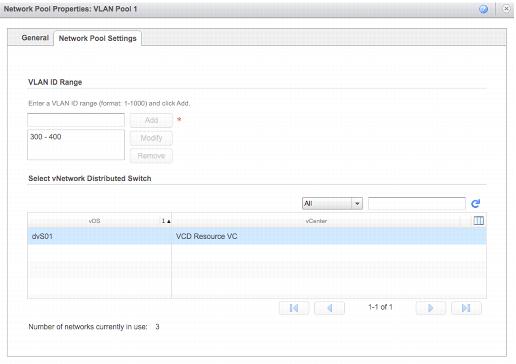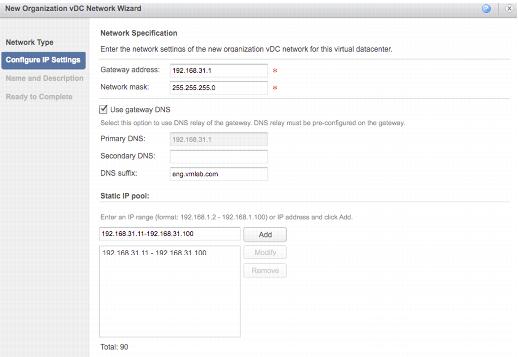4.7.2 Example
The VLAN-
backed network pool
example
(
Figure 22) demonstrates
how the VLAN networks are created automatically in vSphere and used in vCloud Director. Figure 22. VLAN Network Pool Example Configuration
The prerequisites for this configuration are as follows:
 vSphere Administrator – A virtual distributed vSwitch that is connected to all vSphere (ESXi) hosts
vSphere Administrator – A virtual distributed vSwitch that is connected to all vSphere (ESXi) hosts that are in the cluster for the underlying p
rovider virtual datacenter.
 Network Administrator – All physical switch port uplinks to the distributed vSwitch configured as 802.1Q VLAN
Network Administrator – All physical switch port uplinks to the distributed vSwitch configured as 802.1Q VLAN t
runk ports and configured to allow VLANs 300–
400 and VLAN 20 for the external network
(vcd-ext-20).
Cloud Administrator
– vCloud Director VLAN-
backed network pool
created with a VLAN ID Range of 300–400.
 Cloud Administrator – (optional) A vCloud Director
Cloud Administrator – (optional) A vCloud Director external network
(vcd-ext-20) if external connectivity is needed.The VLAN-backed network pool settings are shown in Figure 23.
Figure 23. VLAN-Backed Network Pool Settings
Cloud Administrator – Two Organizations (Engineering and QE) provisioned.
 Engineering
Engineering organization
– “High Engineering PAYG” o
rganization virtual datacenter
 Network 1
Network 1 –
“Eng-Ext-Org-Route” organization
virtual datacenter
r
outed network
 Engineering
Engineering organization
– “Default Engineering PAYG” o
rganization virtual datacenter
 Network 2
Network 2 –
“Eng-Ext-Org-Direct” organization
virtual datacenter
d
irect network
 Network 3
Network 3 –
“vAppNet-ubu1104” vApp network
 QE
QE organization
– “High QE PAYG” o
rganization virtual datacenter
 Network 4 – “QE-Iso-Org”
Network 4 – “QE-Iso-Org” organization
virtual datacenter
Isolated network
During the creation of an organization virtual datacenter, you can choose the network pool (VLAN Pool 1) to associate with this virtual datacenter. Multiple and different virtual datacenters within an organization can share the same network pool, but where appropriate they are assigned separate and isolated networks from the pool.
Table 14. vCloud Director Networks
Network | Network Type | Org | Organization Virtual Datacenter | Network Pool | Subnet |
Eng-Ext-Org-Route | Organization virtual datacenter routed | Engineering | High Engineering PAYG | VLAN Pool 1 | 192.168.31.0/24 |
Eng-Ext-Org-Direct | Organization direct | Engineering | Default Engineering PAYG | N/A | 192.168.20.0/24 |
vAppNet_ubu1104 | vApp NAT | Engineering | Default Engineering PAYG | VLAN Pool 1 | 192.168.32.0/24 |
QE-Iso-Org | Organization isolated | QE | High QE PAYG | VLAN Pool 1 | 192.168.33.0/24 |
Table 14 illustrates that only the d
irect c
onnect organization
virtual datacenter
network does not use a network from the network pool.
Organization direct connected networks use a bridged connection from the external network requiring IP configuration on the virtual machines that matches the physical network IP configuration.
After the network pool
is created and associated with an o
rganization virtual datacenter
the network pools can be consumed. Whenever a routed or isolated organization virtual datacenter
or vApp network is created, vCloud Director automatically provisions
a port group on dvS01 and assigns
it a VLAN from the range that was defined for VLAN Pool 1 (300–400).
The only thing that needs to be completed by the Administrator is to define the IP address
settings for this network
, as shown in Figure 24.
Figure 24. Organization Virtual Datacenter Network – IP Address Settings
The VLAN-backed network pool example (
Figure 25) leverages 802.1Q VLAN trunk ports to allow the physical switching infrastructure to pass all VLANs configured (300–400) to the ESXi hosts, while still keeping the individual VLANs separated and in separate broadcast domains. The dvSwitch delivers the appropriate Ethernet frames to the appropriate port group based on a match of the VLAN tag on the frame and the VLAN associated with the port group. The dvSwitch port groups remove the VLAN tag from the Ethernet frame and deliver it to the appropriate virtual machine. This architecture is commonly referred to as Virtual Switch Tagging or VST. This isolation also persists across the physical switching infrastructure, allowing isolated communication between virtual machines connected to the same vCloud Director network even if they are on different ESXi hosts in the vSphere cluster.
Figure 25. Network Pool Corresponding vSphere Port Groups




